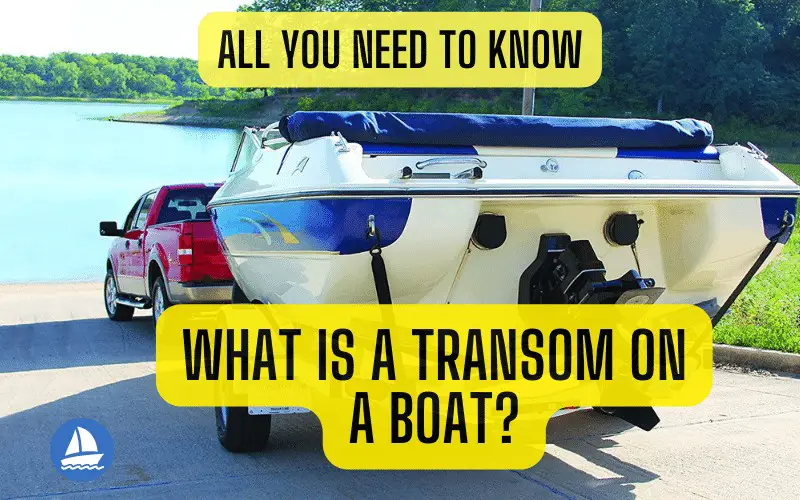A “transom” on a boat is a flat or slightly curved surface located at the stern or back of the ship. It is part of the hull that forms the stern and provides a surface for attaching the outboard motor, propeller, and other stern-mounted equipment.
In addition to supporting the motor, the transom may have a boarding ladder or swim platform attached to it, making it easier to climb in and out of the water when swimming or diving.
The transom is an essential part of the boat, as it helps to control the boat’s direction and stability, and allows the motor to function properly.
It is typically made of strong, durable material, such as fiberglass or wood, and is designed to withstand the stresses and strains of boating.
What Is The Transom Used For?
The transom is a vertical reinforcement that strengthens the stern of modern boats. The transom on a boat serves several important purposes:
- Mounting point for the motor: The transom provides a sturdy and secure platform for attaching the outboard or inboard motor, propeller, and other stern-mounted equipment. This allows the boat to move through the water with power and control.
- Stability and control: The transom also helps to stabilize the boat and control its direction. It plays a key role in maintaining the boat’s balance and preventing it from tipping over or rolling in rough water.
- Boarding and swimming: The transom may have a boarding ladder or swim platform attached to it, which makes it easier to climb in and out of the water when swimming or diving. This is especially important for larger boats, which may be too high above the water for easy access.
- Storage: The transom may also have storage compartments built into it, which can be used to store fishing gear, safety equipment, or other items.
Overall, the transom is an important part of the boat’s design and functionality and is essential for safe and enjoyable boating.
Are The Stern And Transom The Same Thing?
No, the stern and the transom are not the same things, although they are both located at the back of a boat.
The stern refers to the entire aft or back end of the boat, including the transom, the rear deck, and the surrounding area. The stern can be further divided into sections, such as the cockpit, the swim platform, or the transom.
The transom, on the other hand, specifically refers to the flat or slightly curved surface that forms the back of the boat and supports the motor and other equipment. The transom is a part of the stern, but it is not the same as the stern itself.
In summary, while the transom is a component of the stern, the stern includes other parts beyond just the transom, such as the rear deck and surrounding areas.
How to Examine and Repair a Boat Transom
Examining and repairing a boat transom is an important maintenance task for boat owners. Here are the steps to examine and repair a boat transom:
- Inspection: The first step is to thoroughly inspect the transom for any signs of damage, such as cracks, rot, or deformation. This can be done by tapping the surface with a rubber mallet or using a moisture meter to check for signs of water infiltration.
- Remove hardware: If repairs are needed, the next step is to remove any hardware or equipment that is attached to the transom, such as the motor, swim platform, or ladder.
- Remove damaged material: If the transom is found to be damaged or weakened, the next step is to remove the damaged material. This may involve cutting away the damaged section and exposing the underlying structure.
- Repair or replace: Depending on the extent of the damage, the transom may need to be repaired or replaced. Repairs can be made using fiberglass cloth and resin or other specialized materials. If the damage is too severe, however, the transom may need to be completely replaced.
- Reinstall hardware: Once the repair or replacement is complete, the hardware and equipment can be reinstalled onto the transom.
- Finish work: Finally, the transom can be finished to match the surrounding surfaces. This may involve sanding, painting, or applying a gel coat.
It is important to note that transom repairs can be complex and should only be attempted by experienced individuals or professionals.
It is also important to follow proper safety precautions, such as wearing protective equipment and working in a well-ventilated area.
Are Boat Transoms The Same Size On All Watercraft?
No, boat transoms are not the same size on all watercraft. Transom sizes can vary depending on the size and type of boat. Larger boats typically have larger transoms, while smaller boats have smaller transoms.
In addition, boats designed for different purposes, such as fishing, cruising, or watersports, may have different transom sizes and configurations to accommodate specific equipment or activities.
The shape and design of the transom can also vary depending on the type of boat. For example, some boats may have a flat transom, while others may have a curved or angled transom to improve performance or stability.
Overall, the size and design of the transom on a boat are carefully considered by the boat manufacturer to ensure that it provides the necessary support and stability for the motor and other equipment, while also optimizing the boat’s performance and handling characteristics.
What Are Boat Transoms Made Of?
Boat transoms can be made of various materials, depending on the type of boat and the manufacturer’s design. Here are some of the most common materials used for boat transoms:
- Fiberglass: Fiberglass is a popular material for boat transoms because it is lightweight, strong, and durable. It is also resistant to water and corrosion, which makes it ideal for use in boats.
- Wood: Wood is another common material for boat transoms, especially in older boats. Woods such as teak, mahogany, or marine-grade plywood are often used because they are strong, flexible, and resistant to water. However, wood transoms may require more maintenance to prevent rot, warping, or other forms of damage.
- Aluminum: Some boats have transoms made of aluminum, which is lightweight and resistant to corrosion. Aluminum transoms are also strong and can provide good support for the motor.
- Composite materials: Some boats may have transoms made of composite materials, such as carbon fiber or Kevlar. These materials are strong, lightweight, and can provide excellent structural support.
The choice of material for the transom depends on various factors such as the size and type of the boat, intended use, and the manufacturer’s design.
A well-built and properly maintained transom made of any of these materials can provide many years of reliable service.
How Does a Boat Transom Support an Outboard Motor?
The transom of a boat is the flat vertical surface at the rear of the hull that supports the weight of an outboard motor. The transom is typically made of reinforced fiberglass, wood, or aluminum.
The outboard motor is mounted on the transom using a clamping mechanism that secures the motor to the transom. The clamp is typically made of stainless steel and is designed to fit over the transom and hold the motor in place.
To ensure a secure fit, the clamp is tightened using a set of bolts or screws that are threaded into the transom. The bolts or screws are torqued to a specific level to ensure that the motor is securely fastened to the transom.
In addition to the clamping mechanism, the transom may also have additional support in the form of reinforcement plates or brackets.
These plates or brackets are designed to distribute the weight of the motor across a wider area of the transom, reducing the risk of damage or failure.
Overall, the transom is a critical component of a boat’s design, as it provides the necessary support for the outboard motor. A well-designed and properly installed transom is essential for safe and efficient boating.
What If You See A Cracked Transom?
If you see a cracked transom, it is important to address the issue promptly. A cracked transom can compromise the structural integrity of the boat and pose a safety hazard to the passengers.
Here are some steps you can take:
- Assess the damage: Inspect the transom carefully to determine the extent of the damage. If the crack is small and superficial, it may be possible to repair it. However, if the crack is large or deep, it may require replacing the transom.
- Consult a professional: It is recommended to seek advice from a professional boat repair technician to assess the damage and recommend the appropriate course of action.
- Repair or replace the transom: Depending on the severity of the damage, the transom may need to be repaired or replaced. Repairing a cracked transom typically involves filling the crack with an epoxy or fiberglass resin. However, if the damage is too severe, it may be necessary to replace the transom entirely.
- Ensure proper installation: If the transom is replaced, it is important to ensure that it is installed correctly to maintain the safety and structural integrity of the boat. It is recommended to have a professional boat repair technician handle the installation.
In summary, if you see a cracked transom, it is essential to assess the damage, consult a professional, and address the issue promptly to ensure the safety of the passengers and the integrity of the boat.
Test Your Transom for Rot
The easiest way to check your transom for rot is to remove some screws and remove some engine bolts. Water spits out of the screw holes when the coring is bad, or if you find that the coring offers no resistance to an awl.

